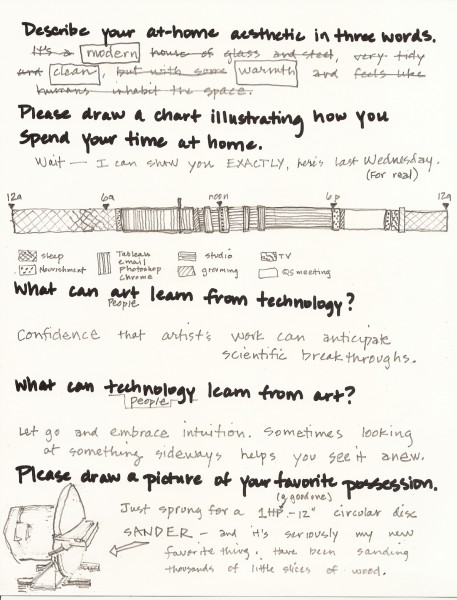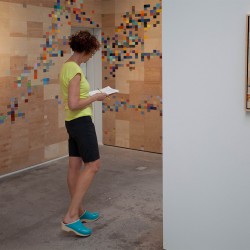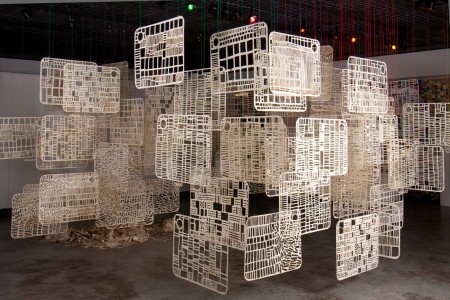3 artists describe the show at Texas State University (Jan-Feb 2014)
/James Sterling Pitt, Deb Sokolow and Laurie Frick. Curated by Mary Mikel Stump at TSU.
James Sterling Pitt, Deb Sokolow and Laurie Frick. Curated by Mary Mikel Stump at TSU.
Here's a little preview of the online and magazine interview with Tribeza (readership is pretty low on this blog - so I don't think I'm revealing anything to more than a handful of friends), by the writer Leigh Patterson. Who by-the-way is fantastic...I was blown away by her first set of online questions. The interview for Profile-in-Style included a photoshoot with a photographer (Jessica Pages) an email set of questions, an in-person visit, and this handwritten questionnaire--which I thought was a retro-interesting way to try to capture personality and humanness. Stay tuned, this along with abunch of photos will be in the Feb issue.


I made the scale well before the disclosures this past year that the NSA was indeed gathering metadata on your phone calls, email, social contacts and search online. I stopped at well over a hundred entries, and every few days I would think of something else that had been captured about me, my behaviour, my financial standing, my medical records. Odd things, inconsequential things, but insightful about me, if all pooled together could paint a picture with more detail and richness than I might be able to even recall about myself. Every movie I’d watched on Netflix, every purchase on Amazon, the location of every dollar spent with a credit card, when I liked to send messages or take pictures on my iphone.
What does all this personal data add up to? Is it a boon to Bluekai and other big data marketers helping companies mine your personal data or just a nightmare scenario for complete loss of privacy? As an artist who grew up in the tech industry and loves technology, I have thought about a future where personal data could become meaningful. Maybe all this vaguely unpleasant surveillance and data gathering about us could turn into a surprisingly insightful view of ourselves and be delivered in ways that will be irresistible.
Am in the midst of writing an arts&culture article for a big science publication....this is the opening paragraphs. Stay tuned.
By Jesc Bunyard in Rooms Magazine
 Laurie Frick’s work treads the line between art and neuroscience. Frick uses self-tracking to map out everything in her life, which then gets transformed into beautiful 2D works and installations. Frick’s practice therefore is human existence in data form, made more tangible for the viewer.
Laurie Frick’s work treads the line between art and neuroscience. Frick uses self-tracking to map out everything in her life, which then gets transformed into beautiful 2D works and installations. Frick’s practice therefore is human existence in data form, made more tangible for the viewer.
What is self-tracking?
It’s about measuring something of yourself, the most interesting tracking comes from capturing something very familiar that you don’t notice. Such as how many times you wake up during the night, your minute-by-minute heart-rate or how many steps you take each day. What used to be something of an oddity, has now become so easy with iPhone apps and gadgets. Self-tracking has exploded into whole movement, called the Quantified-Self.
Your work draws inspiration from neuroscience and from your background in engineering and high-technology. What is it that makes the topics so interesting to you?
At this moment in time biotechnology and neuroscience are exploding, it’s where the biggest breakthroughs in science will come over the next decade. The moment that neuroscience was able to study live human brain activity using fMRI – what we call ‘brain scans’ the field of neuroscience research went into lightspeed. In my lifetime, we’ll begin to understand one of the last true mysteries on the planet – the human brain.
I’m halfway through my 2 year artist-in-residence program at the Poldrack Lab at UT. It’s the Neuroscience Research Center at the University of Texas, Austin, headed by Russ Poldrack, and filled with PhD’s. I get to hang out with them and let some of their smarts and research seep into my artwork.
What visual/aesthetic decisions go into transforming the information into art works?
I have this idea that in the not-so-distant-future, data gathered about us will turn into physical patterns that we display as art. Human data portraits. These patterns are unique to us, and yet unconsciously recognizable as human… as us, familiar and reassuring. I try to look at the data and make a fifty-fifty decision about how to convey what is getting measured with what that data means, and the experience surrounding it. Almost a visual language for conveying human pattern.
Do you decide what data goes in which piece, is one piece made up by category e.g. heart rate, or is a piece made by the data in one day?
I think of the art and each piece I create as ‘experiments’ trying to see if I can make a visual representation of the measurements and help the patterns feel compelling and interesting. So far I’ve taken single measurements that I really understand and make installations and works from those. Combining measurements to see correlation between them, such as did the amount of walking affect sleep or weight is much, much harder. But, measurements over time are always a consideration. I like to work in chunks of time of a day or a month, it’s similar to how we normally see ourselves.
Where would you consider your work to sit in relation to both art and neuroscience? It’s squarely in the art-world, but I have this fantasy about artists seeing something of the future and eventually it turns out to be proven science. I hope that before I die, neuroscience and projects like the Human-Connectome which is mapping the human brain will find patterns or rhythms of the self that can be reflected in the visual world.
What visual/aesthetic decisions go into transforming the information into art works?
I have this idea that in the not-so-distant-future, data gathered about us will turn into physical patterns that we display as art. Human data portraits. These patterns are unique to us, and yet unconsciously recognizable as human… as us, familiar and reassuring. I try to look at the data and make a fifty-fifty decision about how to convey what is getting measured with what that data means, and the experience surrounding it. Almost a visual language for conveying human pattern.
Do you decide what data goes in which piece, is one piece made up by category e.g. heart rate, or is a piece made by the data in one day?
I think of the art and each piece I create as ‘experiments’ trying to see if I can make a visual representation of the measurements and help the patterns feel compelling and interesting. So far I’ve taken single measurements that I really understand and make installations and works from those. Combining measurements to see correlation between them, such as did the amount of walking affect sleep or weight is much, much harder. But, measurements over time are always a consideration. I like to work in chunks of time of a day or a month, it’s similar to how we normally see ourselves.
Where would you consider your work to sit in relation to both art and neuroscience?
It’s squarely in the art-world, but I have this fantasy about artists seeing something of the future and eventually it turns out to be proven science. I hope that before I die, neuroscience and projects like the Human-Connectome which is mapping the human brain will find patterns or rhythms of the self that can be reflected in the visual world.
Data artist exploring the future of data about you.
Email me at: laurie@lauriefrick.com
Signup for VERY occasional email updates, about twice a year with news of shows and projects.
Talks, videos and media